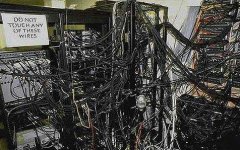I don't see a problem not disconnecting the neutral in the transfer switch.
The neutral originates at the center tap of the distribution transformer (on the utility pole or in ground power company box) and runs to the main panel it must be bound to the earth ground at the service entry or main panel of each house. I believe but have not found a reference that it is also bound to a ground at the utility transformer (via the ground wire running down the utility pole from the transformer to a ground rod).
If there was a non-zero voltage on the utility side on the neutral line it would be a shorted to ground at EVERY house and possibly at the distribution transformer.
In fact the NEC specifically allows the neutral to not be switched by a generator transfer switch. (It also allows the neutral to be switched with an additional generator ground requirement).
The NEC itself is not online but I found the following online pages which quote or paraphrase the section of the NEC:
<font color=blue>
from
http://www.egsa.org/standards/_docs/word/std109c.doc
250-5(d). Separately Derived System. This section requires grounding a separately derived system meeting the requirements of 250-5(b). A generator may or may not be a separately derived system. A fine print note explains that an on-site generator is not separately derived if the neutral is solidly interconnected to a service-system supplied neutral. Such generators should not be separately grounded. Other generators are separately derived and must be grounded if they can be grounded at 150 volts or less to ground or supply 480/277 volts.
</font color=blue>
<font color=blue>
from
http://www.lni.wa.gov/scs/electrical/currents/elc98_11.pdf
NEC 250-5 (FPN No. 1) states: An alternate alternating-current power source such as an on-site generator is not a separately derived system if the neutral is solidly interconnected to a service-supplied system neutral." The most common example of this is an on-site generator installed as a backup source of power. This is the type that would employ a transfer switch to transfer utility and generator power. The transfer switch does not break the connection between the generator neutral and the utility grounded circuit conductor (neutral). The generator is required to have an equipment grounding conductor to ground any exposed noncurrent-carrying metal parts. This equipment ground must be a type specified in NEC 250-91(b) and run from the normal system ground to the generator frame. It should be noted that a supplementary grounding electrode at the generator location is allowed under NEC 250-91(c). A grounding electrode is not required by the NEC, but could be recommended by the generator manufacturer.
</font color=blue>
The section is also quoted is also in:
http://www.eren.doe.gov/der/microturbines/pdfs/mtstandards.pdf page 5.5
The transfer switches intended to switch a 220 volt service between utility service and a generator I have found are two pole switches (switching the two hot lines) with a non-switched neutral. This includes both the manual switches and the automatic switches (see the Kohler web site
http://www.kohlerpowersystems.com/onsite_ts_auto_all.html for example).
(I currently have the 12 circuit gentran transfer switch I had installed when I built the house, this was a mistake. I had the panel rewired once to change the 12 circuits and still don't have the 'right' 12. I have been looking at both an LP system with automatic start or a manual 200 amp transfer switch. )

